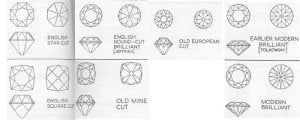I gave my wife my great-grandmother's engagement ring which has a 1/3 caret diamond in it which I assume is one of these cuts. My mother said it was an 'old english' cut but she probably just got that from the mall employee who retouched up the prongs about 20 years ago. I had assumed that these two terms were synonyms but then I was looking around and saw several diamond reports that listed the cut as 'old english' Additionally I saw it stated somewhere that old euro cuts all have a culet. Our stone appears to be very circular (which would rule out old mine cut I believe) but does not have a culet. So now I am wondering just exactly what it is.
Any thoughts?
2nd question. This ring is on its last legs one prong tip has broken off, 2 others appear cracked and two of the side diamonds are cracked. I talked to a couple of local jewelers and they suggested throwing away the old setting and rebuilding completely. I decided to get my wife an upgrade as I never had to spend any money on the first one 20 years ago and I can afford to now. We are going with a ring based on this http://www.jamesallen.com/diamond.asp?find=1&cid=130&item=1091996
So we don't really need another engagement ring. I'd say earrings but it seems like it would be pretty tough to match this with any other stone. What would you do?
Any thoughts?
2nd question. This ring is on its last legs one prong tip has broken off, 2 others appear cracked and two of the side diamonds are cracked. I talked to a couple of local jewelers and they suggested throwing away the old setting and rebuilding completely. I decided to get my wife an upgrade as I never had to spend any money on the first one 20 years ago and I can afford to now. We are going with a ring based on this http://www.jamesallen.com/diamond.asp?find=1&cid=130&item=1091996
So we don't really need another engagement ring. I'd say earrings but it seems like it would be pretty tough to match this with any other stone. What would you do?





300x240.png)